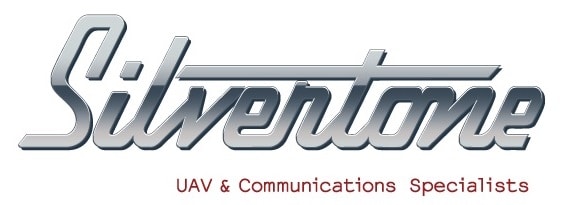The Silvertone Story
As told by founder Bob Young.
John Marquette established Silvertone® in Australia in 1958. John’s company, Advance Radio Control, produced Silvertone® single channel valve equipment and later multi-channel reed equipment again using valves. In 1963 Bob Young purchased the Silvertone® radio manufacturing section and established Silvertone® Electronics.

Silvertone®® Air Force circa 1974. Silvertone®® Weightlifter Mini RPV’s awaiting delivery.
Thus Silvertone® may be considered the pioneers of radio control in Australia. From Single channel valve super-regenerative receivers to 24 channel solid state super-heterodyne digital proportional receivers has been a giant step and Silvertone® has gathered a wealth of experience in the process.

Finished Stingray-A ready to fly.

Dawn Patrol. Single retract nose-wheel with wheels in
the tailplane tips left the underside of the wing perfectly clean.
No disturbed air from wheel wells. A very fast aerobatic model.
Amongst our list of Australian R/C firsts are included the first commercial production of R/C gear which included single channel and reed, valve and transistor transmitter and receivers. In 1966 we produced the first Australian designed and built digital proportional system, the Silvertone® Mark 1.

Bob Young with model at the World Aerobatic Championships, Pennsylvania USA, 1971

Reserve model at the Worlds. Note the parachute for emergency recovery.
In 1971 Bob Young along with Brian Green formed the first Australian team to fly in the World Aerobatic championships. The late 1960s and early 1970s were the first of several peak periods in Silvertone® creativity.

Could this be construed as sitting down on the job? A very young Bob Young (c 1969) with his “flying-chair”. Utilising a Silvertone® Mark 1 proportional transmitter, the chair was actually a prototype dual control (buddy box) system with the chair control pots wired directly into the encoder. Uncomfortable and difficult to use at first, the chair proved to be quite successful eventually, especially on twin engine models. Note the dual throttle levers. The aircraft shown set the first Australian R/C speed record of 133mph.
In 1969 we introduced the Silvertone® Mark VII system, a very advanced system for its time. It was the first Australian R/C system to be written up in International magazines. The Mark VII was particularly well received in the USA, receiving an excellent review in RCM magazine. The Mark VII was the first Australian R/C system to feature narrow band spacing, frequency interlock and dual control. The Mark VII ushered in a new era in Australian R/C operations. The narrow band feature presented clubs with some interesting problems and opportunities which they had never encountered before. From a club point of view, the introduction of narrow band operations (from 50kHz down to 15kHz, increasing available frequencies from 6 to 18 frequency slots) completely revolutionised club R/C operations in Australia.
The first problem was how to take advantage of the narrow band feature of the Mark VII, whilst maintaining safe operation for older and wider (40-50kHz) systems. The old peg-on transmitter system proved to be totally inadequate and actually unsafe in this situation. Silvertone®‘s answer to this dilemma was to develop the Silvertone® Keyboard, a device that can safely control the simultaneous use of radio control systems of differing bandwidths.

Early days. Riverwood workshop c1972. Colin Kennedy (foreground) and Eric Avery working on Mark VII TX. Many of these were exported all around the world. Eric in previous lives was an RAAF transport pilot and Chief check pilot for ANA airlines.
The Silvertone® keyboard was used in almost every R/C club in Australia and was finally declared the Australian National Standard Frequency Control System until the introduction of 2.4GHz sets rendered any form of frequency control unnecessary. Prior to the introduction of 2.4GHz all MAAA sanctioned contests used the Silvertone® keyboard as the frequency control system. It is still to our knowledge the only variable bandwidth frequency control system that was available on the World market.

Silvertone® 36MHz Keyboard showing 10kHz key on left and 20kHz key on right.

Reverse side of key showing Interlock plug. Key plugs into TX when not in use cutting off all power to the transmitter, thus rendering it safe when returned to the pits.
The development of the Keyboard in turn led directly to the concept of frequency interlock to prevent accidental shoot-downs from transmitters left on in the pits. As each transmitter has its own key in this system, the logical extension is to use that key to turn off the transmitter when the key is not in the Keyboard. Thus by plugging the key into the transmitter, power is removed from the electronics, thereby rendering the transmitter completely safe whilst in the transmitter pound. All Silvertone® transmitters built since 1969 have featured Frequency Interlock.

In 1970 we undertook to radio control a full size VW 1600TLE for Volkswagen Australia for use in a TV advertisement featuring the “Car that thinks for itself”. The VW1600TLE was one of the first cars to feature a computerised engine management system.
This was subsequently demonstrated all over NSW and proved to be of great interest to disabled people who could see the potential for a car that could be driven with two fingers. It was a real head turner when driven from the back seat with no driver up front.

In 1973 we began to investigate the use of R/C aircraft in military training applications. To this end we began the development of all fibreglass aircraft, such as the Silvertone® Stingray shown below.
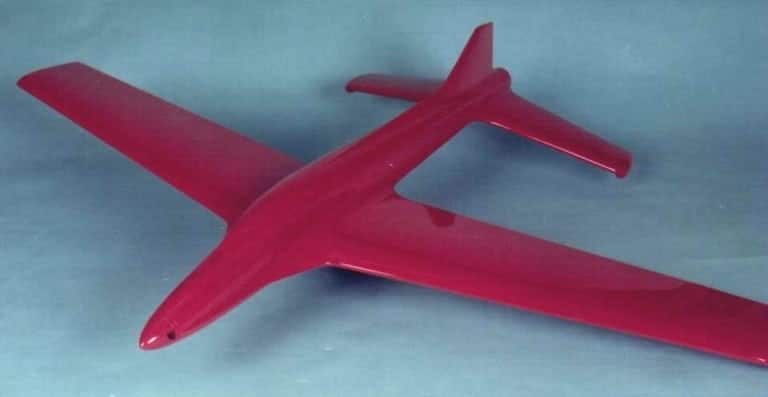

Wooden plug for Silvertone®® Stingray-A one of the world’s first all fibreglass models. (c1974)
This was intended as a proof of technology aircraft for later all fibreglass aircraft such as an all glass Weightlifter (never built) and a larger delta aircraft (De Havilland Enmoth) and ultimately the Silvertone® Flamingo®.

Stingray components straight out of the mould. Glasswork by Alan Trinder, aircraft design by Bob Young. Model came out of the moulds in two pieces. Joined fuselage with integral fin and tailplane and complete wing.

A young Basil Healey with a De Havilland Enmoth.
As a result of our technical prowess in the manufacture of fibreglass airframes we were contracted to undertake the development of the all glass Enmoth airframe designed by De Havilland Aircraft Bankstown. In all we built 15 Enmoth airframes for De Havilland Aircraft Australia. Silvertone® ultimately supplied all of the fibreglass delta airframes for this project.

Model in a Box.
Silvertone® Weightlifter prototype in carry case.
Designed and built by Alan Turton. (c.1974)
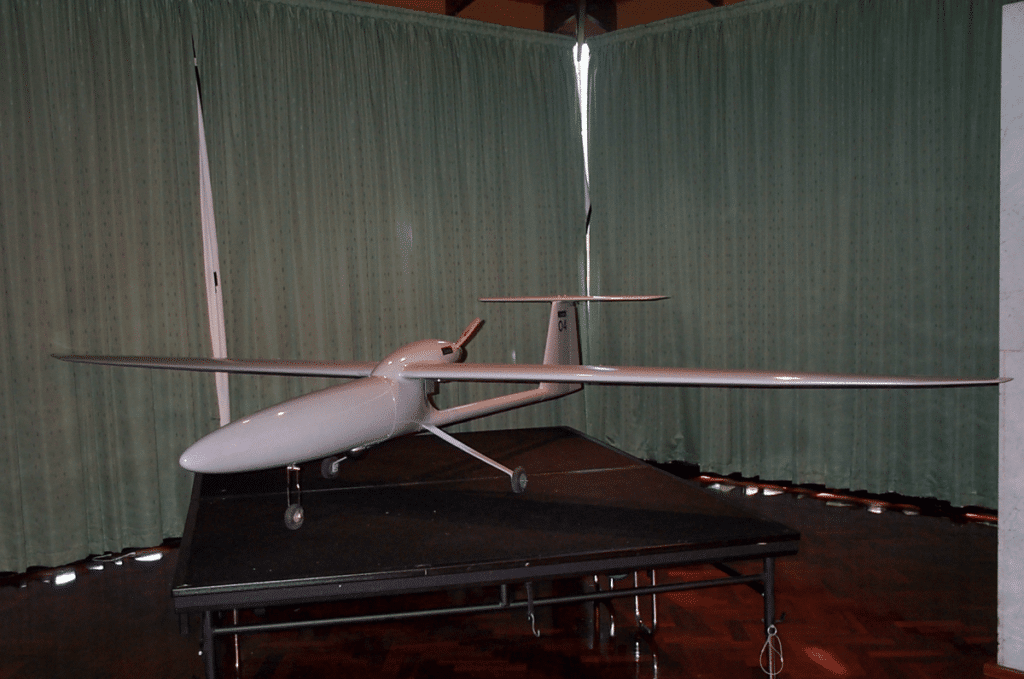
Silvertone® Flamingo® F-04 on display at the Christchuch University, NZ.
The Flamingo® drew heavily on our Stingray and Weightlifter experience.

Barry Ming, master craftsman with his faithful companion
Blue Dog and three Silvertone® MAT-DF aircraft ready for firing trials. This was an immensely
successful target and the gunners loved them for the modern realistic profile they presented in flight.

Silvertone® Falcon A trainer/target aircraft c1988. Part of a batch of 12 made for the Australian Defence Force. A more conventional trainer/target.
Many Stingrays were sold to modellers throughout Australia. At the same time production commenced on the Silvertone® Weightlifter RPV, designed as one component of a company funded missile training system. Many of these were sold to various Government departments including Weapons Research (SA) and the CSIRO, performing a variety of chores including atmospheric sampling, missile training, weapons testing etc. We also flew missile training missions (Redeye shoulder launch missile) for the ADF.
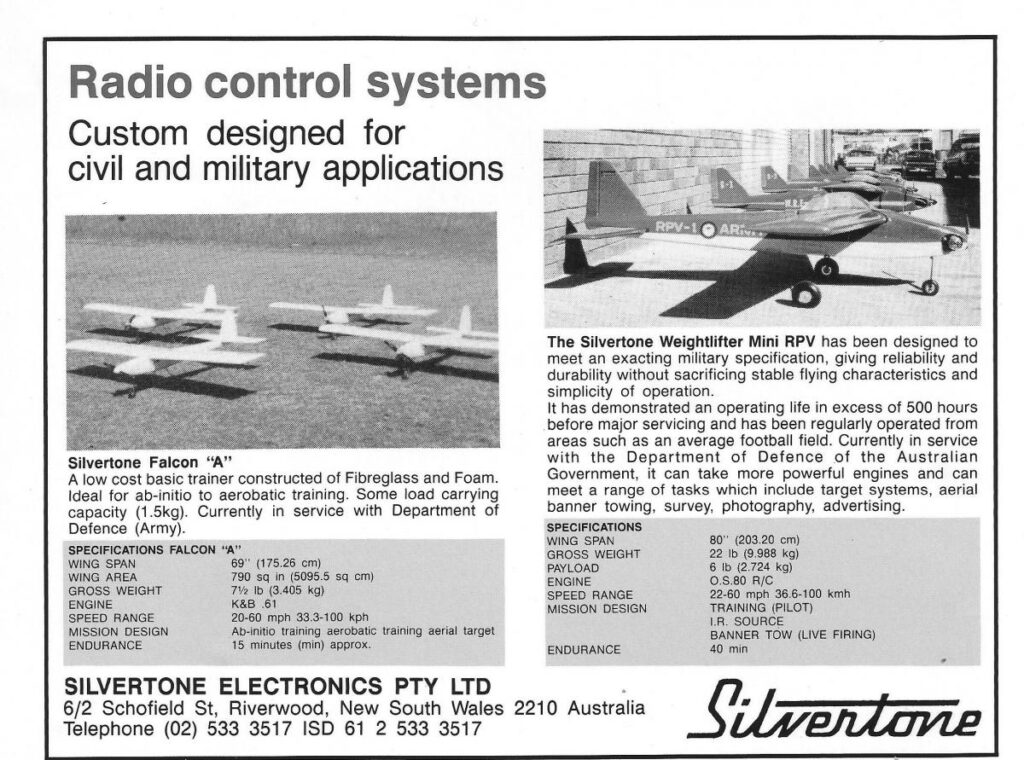
An advertisement from the Australian Defence Equipment Catalogue, 1985 – 86.
During the 1980’s a series of disposable fast, small foam delta target aircraft (MAT-DF) were also built in this period and used for small arms air-defence live-fire training. This aircraft was immensely popular with the trainee gunners proving to be a very realistic target. The final aircraft in this series was the Silvertone® Falcon A, a 60 powered, live-fire target/trainer supplied to the Australian Army. All of the projects above were the first of their kind in this country.
We also pioneered such concepts as the first commercial model flying school when we set up the Silvertone® Flying School which operated for many years. This scheme evolved into the RCAS (NSW State) instructors training system before finally growing into the Model Aeronautical Association of Australia (MAAA) National Flight Training system. We also fostered many records, helping Silvertone®® customers to establish records that stood for many years. Actually the official Australian R/C aircraft speed record (133mph) set by Bob Young in 1969 is still the current Australian record.
Along the way such projects as radio control full size cars, trucks and trains, machines, target RPV’s, Hollywood movie robots, radio controlled buildings etc have provided interesting diversions and added to our store of R/C knowledge and experience.

Mark 22 TX and Rx modified for use with the PDC3100
autopilot ready for installation into the Observatine UAV.

Bob Young with Alakazam the Robotic Puppet (Dummy on the left). T
hirty-two channels, voice synchronous lips, blinking eyelids. Control tape was built up in layers,
four channels at a time. All before computers. Used in a Hollywood Children’s TV pilot trilogy c1979 .

On the set of Safe Eddy and Alakazam in Denver, USA. Note the 32 channel TX on Bob’s lap.
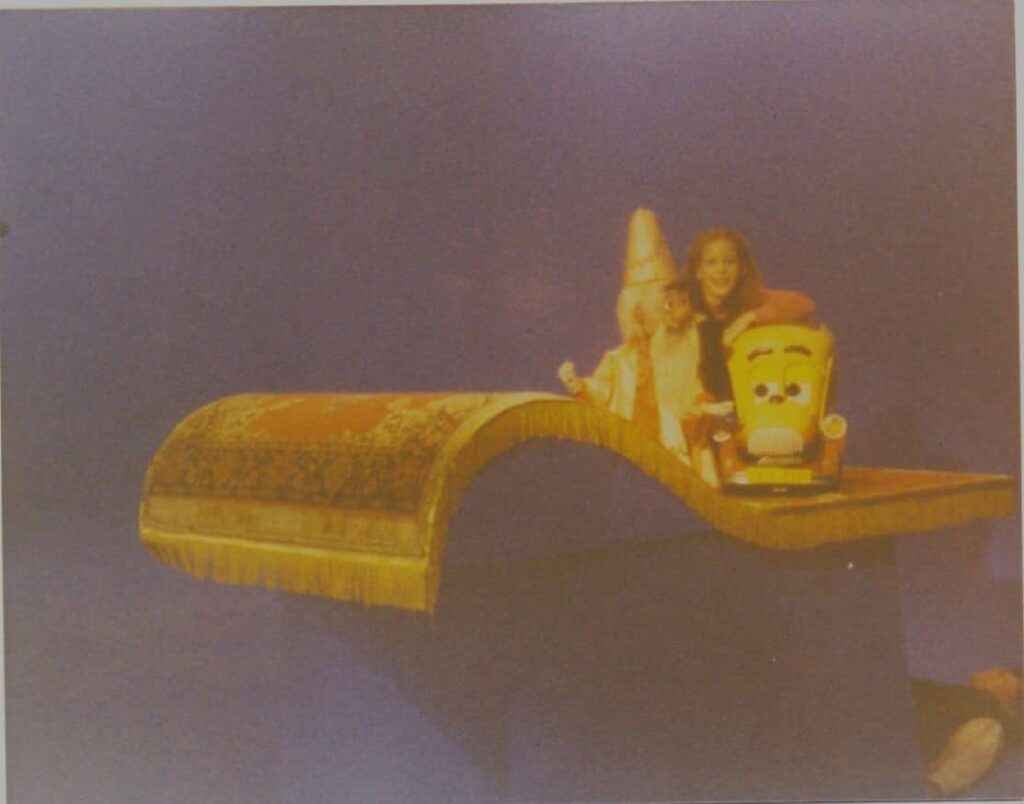
Cast of Safe Eddy and Alakazam. From left, Alakazam, Violet
and Safe Eddy. Here they go on a magic carpet trip.
Note fellow on ground. His job was to rock the carpet with his feet to simulate movement.
One of our more interesting experiences involved radio controlling the window washing robot used by the Sydney Opera House. Another being the designing and building of the R/C pyrotechnics trigger system used in the film trilogy “Lord of the Rings.” One of the explosive sequences in Part 2 won an award for the best pyro scene.

Mark 22 TX modified for the Lord of the rings project.
Note the 24 trigger contacts embedded in the right side of the TX.

Silvertone® Mark 22 variant used in the Lord of the Rings trilogy. 24 Channel (Black TX) with a standard TX used as a safety master arming switch. Note the probe near the black TX. This was run along a series of 24 contacts on the front panel of the black TX to produce a machine gun effect and other pyro effects. 24 Channel RX on the left.
One project after another tumbled out of the Silvertone® workshop over the years in a wildly diverse array, contributing along the way to a very exciting and interesting life for all of those involved. And helpers there were aplenty. Far too many to name personally but they know who they are. Those men and women who helped design and build the equipment and the customers that commissioned the projects made all of the above possible and to them goes a special thank you. I could not have done it all on my own.
However our first love has always been the radio control of model aircraft. Perhaps the following citation covering the MAAA Life Membership award granted to Bob Young in 1991 explains this most clearly:
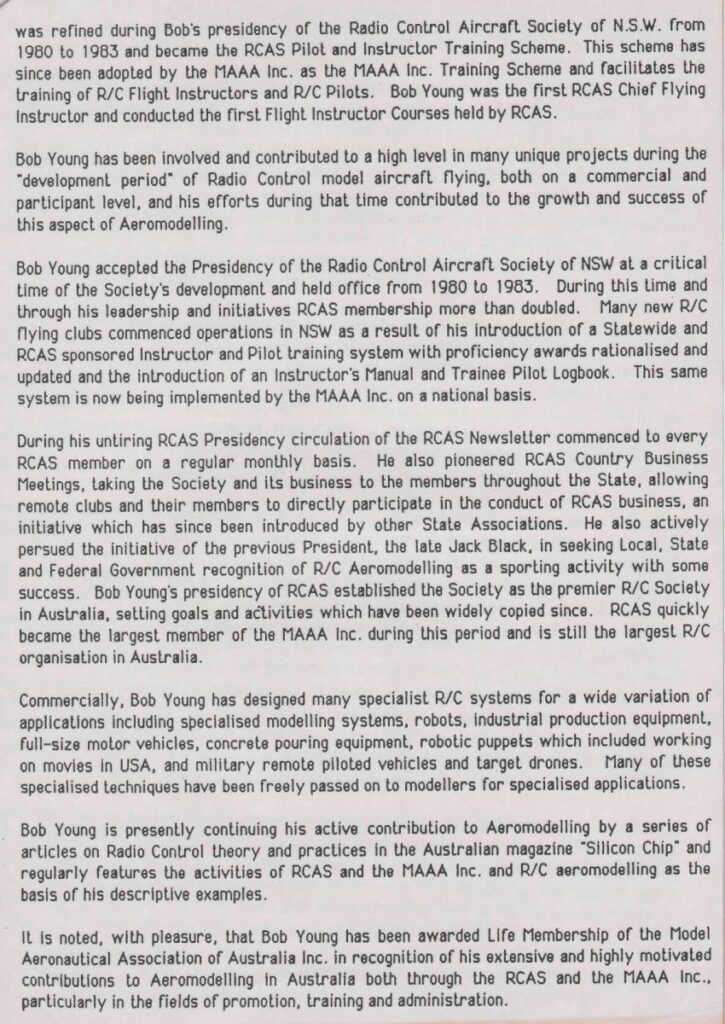
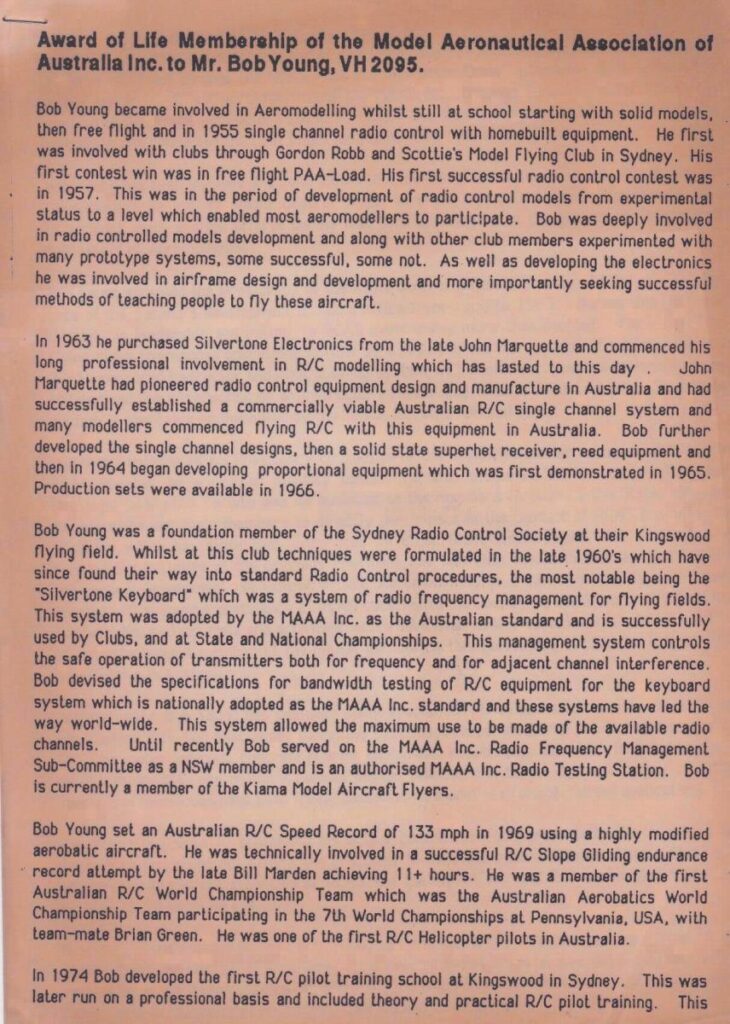
In the early 1990’s we began investigating autonomous flight and aerial video photography.

Aerocommander UAV, one of our first aircraft fitted with autonomous flight equipment and a camera.
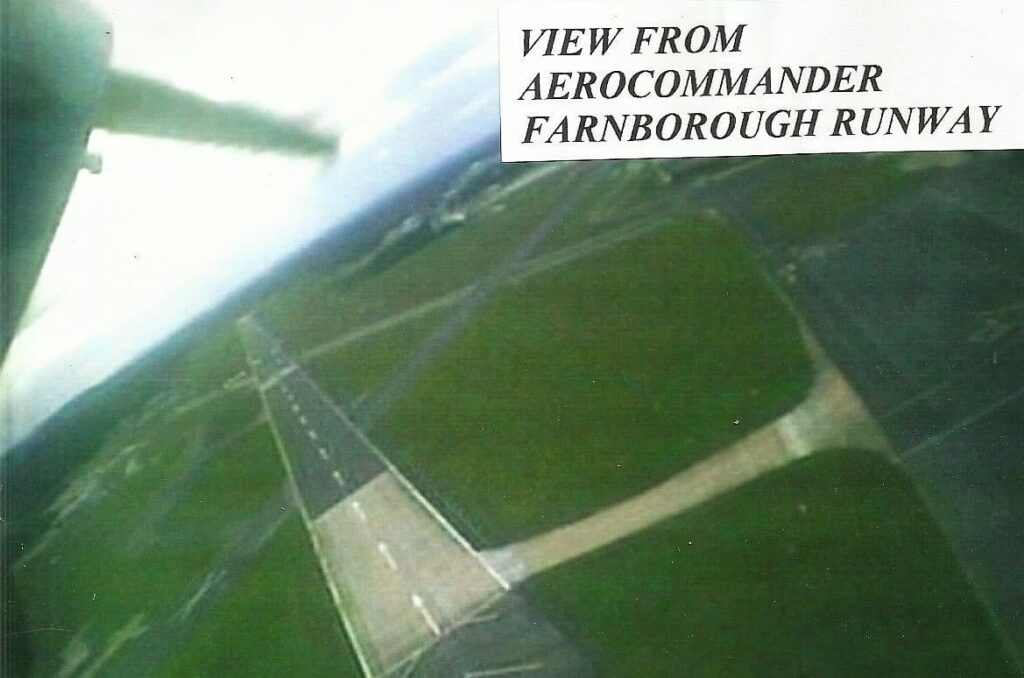
A view up the main runway at Farnborough UK.
Using Weightlifters and a small Aerocommander sport model as the airborne test-beds we began testing various camera and autopilot systems.
At about this time we made contact with Zina Kaye and her husband Snow who had a grant to investigate designing a UAV intended to take aerial real time video under control of web based customers. This UAV was intended to orbit over well-known landmarks while web based customers controlled the camera angles and aircraft positions from their home computers. It was in effect an early attempt to do what Google Earth now does so well. Our flights on Farnborough Airport in the UK were a result of one of Zina’s projects.

Silvertone® Observatine UAV with a batch of high power Mark 22 Military specification Transmitters.
This UAV shown above was the first Silvertone® purpose built and designed UAV and it used a PDC 3100 autopilot and a Crossbow IMU. This was the aircraft caught up in the incident during the Sydney Olympics which is described in “Small UAVs and how they work”.
Zina christened it Observatine. We rather unkindly christened it the “Flintstone Flyer” as a tribute to its rather ungainly appearance. Fitted with a Zenoah 60cc twin cylinder motor it actually flew very well. Along with a camera the Observatine was also fitted with an emergency parachute recovery system. It was our work with Observatine that gave us the experience required to undertake our Flamingo® project.
The three Silvertone® Mark 22 transmitters pictured alongside Observatine are high powered transmitters from a batch built for Continental RPV in California USA. These transmitters were used for controlling target RPVs over long distances on US military target ranges.
Also in the late 1990s we turned this wealth of age-old experience towards creating an absolutely unique radio control system, the Silvertone® Mark 22. The 1990s were another very busy and productive time for Silvertone®. The Mark 22 has grown into something more exciting than we originally planned. The modular concept has virtually no limits and we are continuing to add new modules as time passes. The Mark 22 formed the basis for the Lord of the Rings R/C pyrotechnics trigger.

Mark 22-A TX left, Mark 22-C right.

Mark 22-SM showing internal modules
The latest module is a dual control transmitter back. Thus fitting dual control to an existing transmitter is now merely a matter of purchasing a new back panel and plugging the leads onto the appropriate pins on the encoder PCB.
System upgrades will be easy to fit and relatively inexpensive, thus the Mark 22 with its robust construction, ease of maintenance and upgrade capacity will serve its owners well into the 21st century. All Mark 22 transmitters and receivers were rated in 2001 for 10kHz operation in preparation for the introduction of this frequency spacing in early 2002, thereby maintaining the long tradition of being in the forefront of developments in narrow band operations in Australia.

Silvertone® Mark 22 Single Stick TX. One of these was exported to Spitzburgen, the closest human habitation to the North Pole.

Silvertone® Stingray Mark 2 (c2001). Note centreline U/C and wire wing-tip skids.
Now comes another very interesting part of the Silvertone® story. In 2005 we began to design what would ultimately become the Silvertone® Flamingo®, a truly unique UAV that has since captured hearts around the world with its elegant appearance, versatility and fabulous flying characteristics.
However before embarking on the story of the development of the Flamingo® a word on our autonomous flight experience, experience that played such a large part in the development of the Flamingo®.
We began investigating autonomous flight in about 1995 starting with Observatine and the PDC 3100 autopilot and Cross Bow IMUs. Along the way we experimented with a variety of small PDC stabiliser units such as the PDC 10, PDC 20, the Ezi-Nav and finally ending up specialising in the ATTOPilot V1 through to V4.
In the year 2001 we first met Dave Jones of AUAV Florida when he and his wife paid a visit to Sydney. This was the start of a long association both technical and one of friendship.
Dave was the first modeller to undertake a long distance autonomous flight in America doing so in 2001. Dave was developing his own autopilot and this was the Ezi-Nav and marketed by Dave’s company AUAV.

Dave Jones’ Ezi-Nav Autopilot.

Interior of the Ezi-Nav.
The Ezi-Nav was the autopilot we used in the 2007 Outback Challenge. Dave’s Autopilot was mounted in a Flamingo® which was modified to carry the bottle of water and the bottle release.
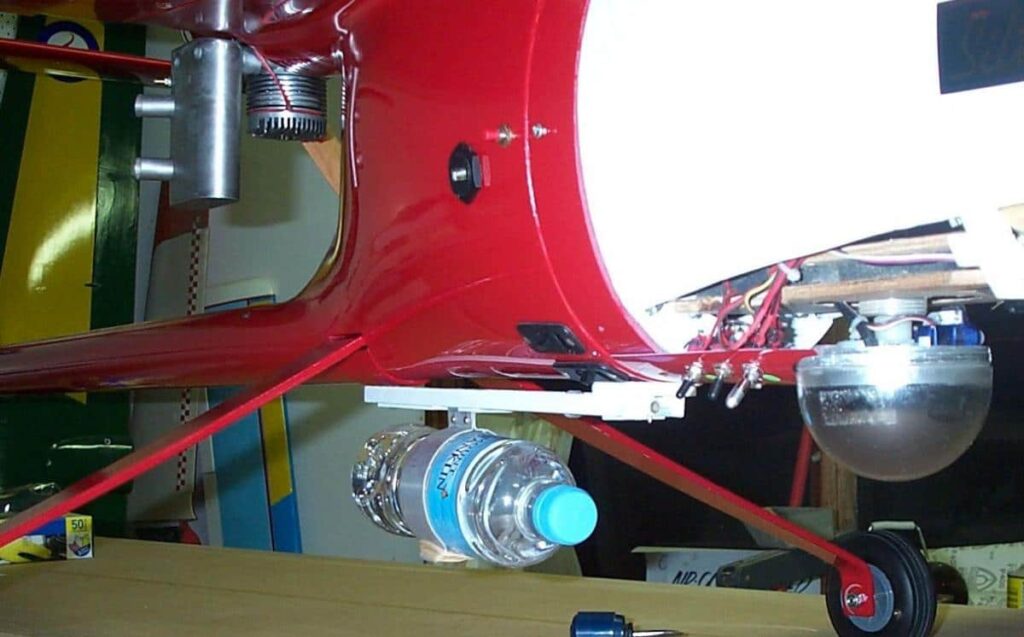
Flamingo® modified to carry camera and water bottle for the Outback Challenge 2007.
Team Silvertone® was one of only two teams to make it to the flight line that year but sadly a last minute transformer failure knocked us out of the race at the very last minute.
Dave went on to become a part of the team that took out the prize in the 2009 Outback Challenge, his partner in that event being Geordie Milne. Dave was also the Silvertone® agent who negotiated the sale of Flamingos to the USAF in 2009.
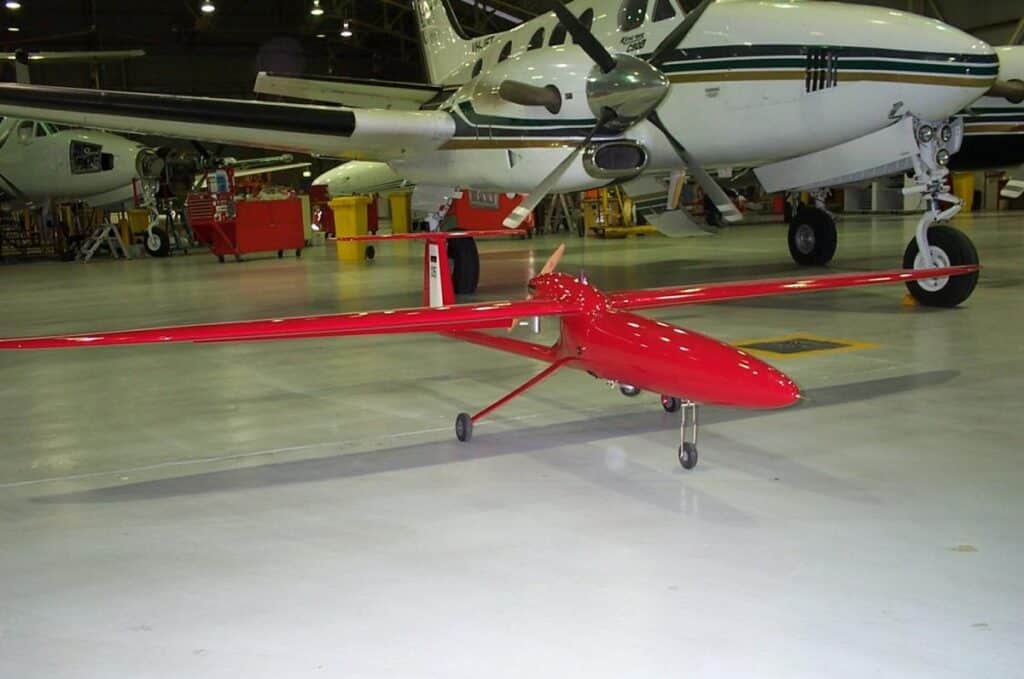
The Silvertone® Flamingo® 05 used in the 2007 Outback Challenge before fitting the water bottle.

At the Outback Challenge 2007. Bill Swan and Dave Jones (Black caps, Team Silvertone®) with the best performer of the 2007 Challenge (Name unknown, Team Dionysus) and his sister.
Photo right, getting ready for the Challenge flight.


Dave Jones with his Flamingo® on the Valkeries field, Florida c2008.
In 2009 we started work with our ATTOPilot autopilot and fitted it into an electric powered Piper Cub. This work was very successful as results below show.

Piper Cub on a test flight prior to the ATTOPilot autopilot being installed

Test flight of the ATTOPilot autopilot on the Dalby Model field. This flight was to establish the performance of the ATTOPilot in strong cross winds.

Happy Killmore’s GCS display showing a 17 orbit flight plotted on Google Earth
As a result of our deep involvement in autonomous flight in 2005 we began to see a need for a small UAV that would fill the gap between the Aerosonde the leading small UAV at the time and the much larger military UAVs.
We could also see a large and very diverse market for small UAVs and hence we determined right from the outset that the Flamingo® would be a versatile as we could make it. Thus we pushed hard at the modular concept to ensure that whatever the customer required we could satisfy that need.
We also wanted to avoid the complications of vehicle mounted launch and the problems associated with high wing loadings often encountered in small UAVs.
Thus we settled on a 4 meter wingspan and focused on making that airframe as aerodynamically efficient as possible with the philosophy that high efficiency would lead to smaller motors thus less fuel and a much lower all up weight at take-off.
That we were successful in that aim is a credit to the people involved in the Flamingo® team. Bob Young the overall concept, master plug making and airframe construction and fitout. John Haren aerodynamic design and detailing, Bjorn Rutley, Marcus Stent and John Copeland fiberglass construction and Barry Ming, Bill Swan, John Haren airframe construction.
Test flying commenced in December 2006 but sadly the first prototype was lost on the maiden flight when the flying speed (150mph) exceed the design limits of the elevator servo and associated hardware leading to a major re-think of all servos and associated hardware fitted to all flying controls. We were, to put it in a nutshell, hoisted on our own petard, being completely caught by surprise at the stunning performance. We set out to make a very efficient aircraft but did not quite expect that result.

The final 3D concept drawing by John Haren. Note the leading edge used on the first three prototypes which were all fitted with a foam and balsa wing. The foam wing was later replaced with a fiberglass wing with a fully elliptical wing planform and wing sections modified to suit the Reynolds number at each station.

The first prototype 01

View from the rear side of 01
The second prototype took to the air in June 2007 and the Flamingo® story was launched. From all of the foregoing it should be quite obvious the design of the Flamingo® was no accident. Years of intense R/C experience designing, testing and flying R/C systems and aircraft have culminated in a UAV which we are all proud to see carrying the Silvertone® Logo into the Future.
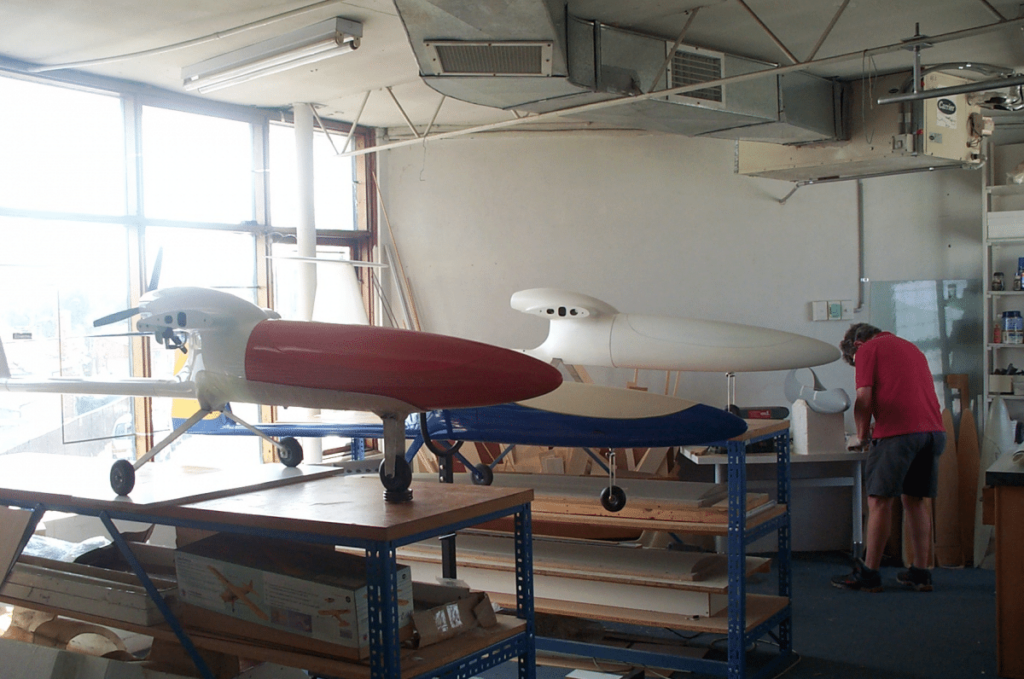
John Haren hard at work in the Riverwood shop.
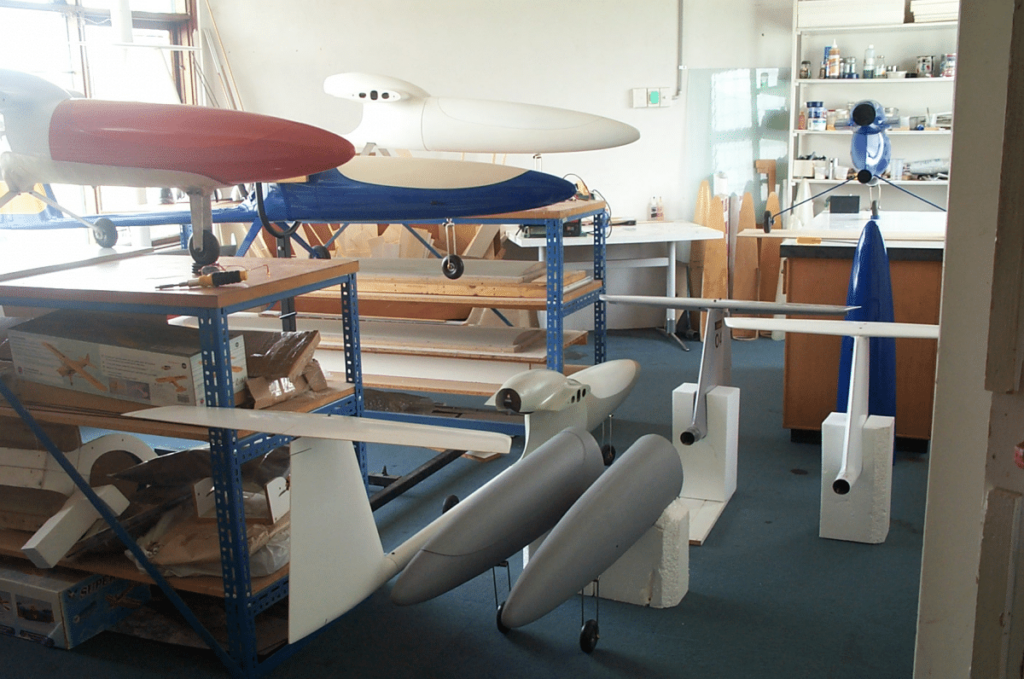
Flamingos on the production line at Riverwood.
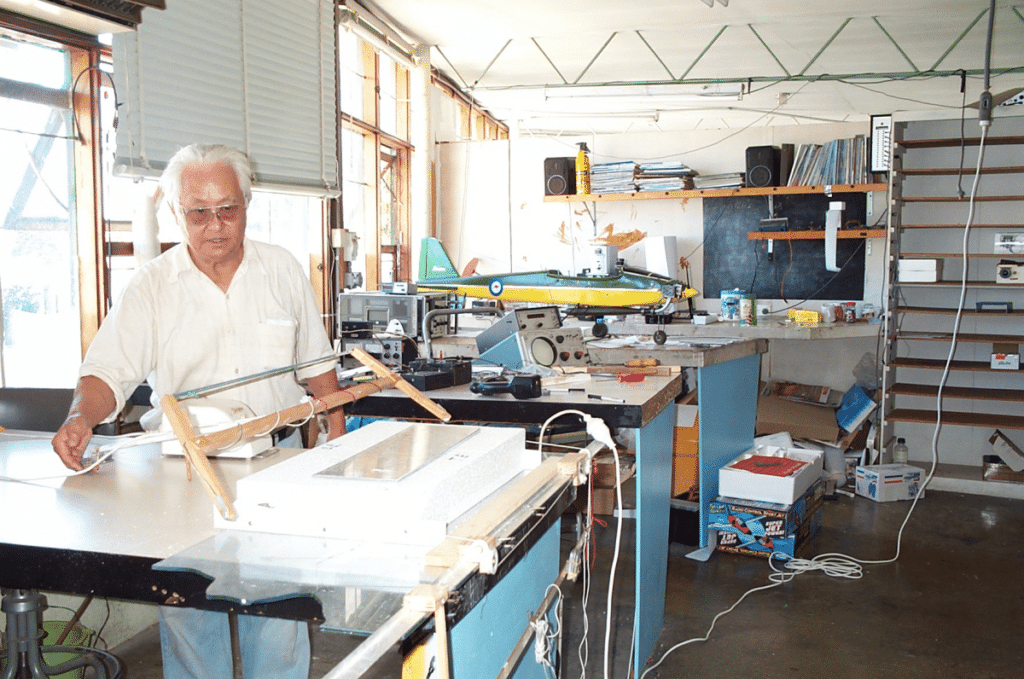
Barry Ming hard at work cutting foam cores Riverwood.

Flamingo® 03

Bob Young with 03 before the yellow trim was fitted. Note wing leading edge.
All Flamingos from 03 on were fitted with the full fiberglass wing as shown below in the photo showing the full set of modules available for the Flamingo® including the twin boom version.

The complete module set for both the single and twin boom Flamingos.
Once test flying was complete and we were satisfied that we had met all of our design parameters we started to let it be known that we had a UAV for sale. In very rapid succession Flamingos were sold to the USAF, The Royal Thai Airforce, Queensland University of technology, Notre Dame University in the USA and various individuals in private sales.

Flamingo® 05 during test flying in Dalby Queensland.
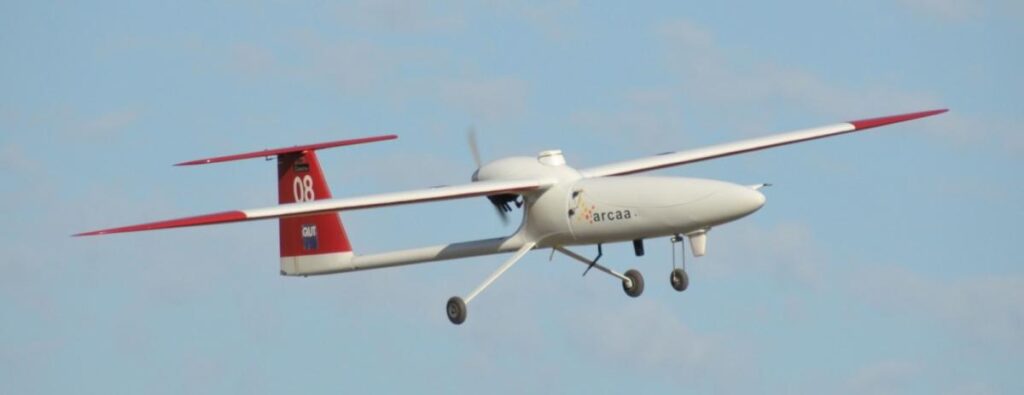
Queensland University of Technology Flamingo® “Carla”. Carla is the hardest working Flamingo® of all, having undertaken all manner of projects from collision avoidance to spoor sampling.
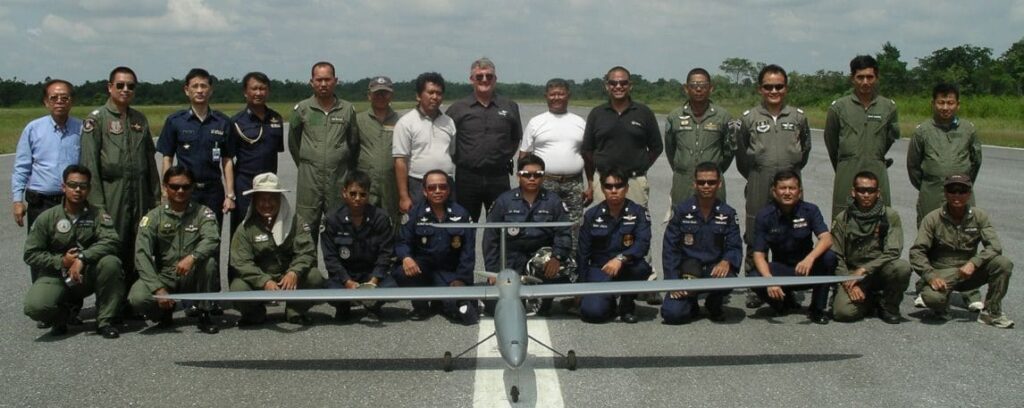
The Royal Thai Air Force Flamingo® Team with Aussie instructor Paul Dewar in the centre rear.

Flamingo® F10, one of the Flamingos supplied to the USAF.
As a result of work carried out in Florida the people conducting the flight testing ordered a twin boom conversion kit in order that they might fit a larger motor to one of their Flamingos. This was a limitation imposed by the single boom Mark 1 and Mark 2 designs.
The Mark 3 Flamingo® has a deeper boom fitting point which allows much larger diameter props thus larger motors, neatly eliminating the need for the twin boom variation.

Notre Dame Twin Boom Mark 2 Flamingo® F18 prior to shipment from Silvertone®. Note the navigation lights.
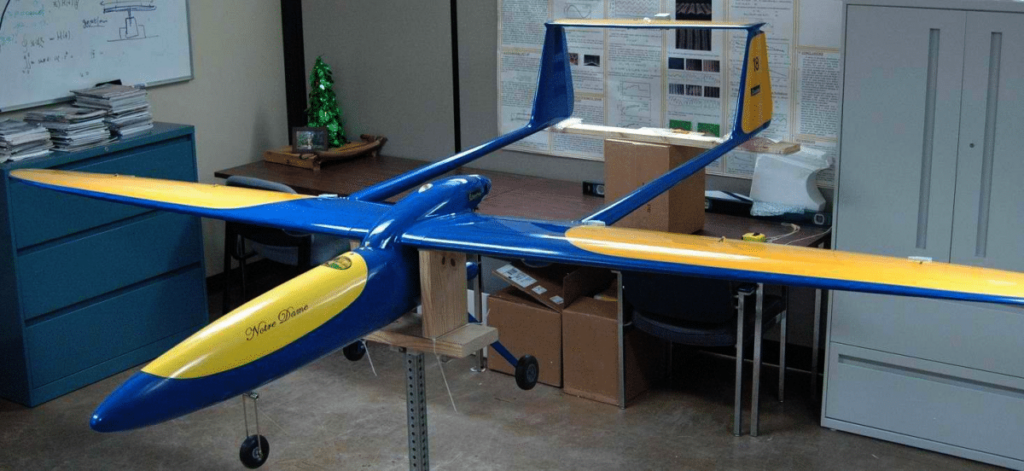
Notre Dame F18 Twin Boom Flamingo® upon arrival at Notre Dame University.

Notre Dame Flamingo® F-18 undergoing surgery in the Notre Dame laboratory.

Notre Dame Flamingo® F-18 after surgery. Note the contrivance known as a Gillsonic mounted on the nose cone.
F-18 was the UAV used in the Matterhorn project investigating the intricacies of mountain weather.
To address scientific needs and help improve the prediction of mountain weather, the U.S. Department of Defense has funded a research effort—the Mountain Terrain Atmospheric Modeling and Observations (MATERHORN) Program—that draws the expertise of a multidisciplinary, multi-institutional, and multinational group of researchers. The program has four principal thrusts, encompassing modeling, experimental, technology, and parameterization components, directed at diagnosing model deficiencies and critical knowledge gaps, conducting experimental studies, and developing tools for model improvements. The access to the Granite Mountain Atmospheric Sciences Testbed of the U.S. Army Dugway Proving Ground, as well as to a suite of conventional and novel high-end airborne and surface measurement platforms, has provided an unprecedented opportunity to investigate phenomena of time scales from a few seconds to a few days, covering spatial extents of tens of kilometers down to millimeters.
The Mark 3 Flamingo® has a deeper boom fitting point which allows much larger diameter props thus larger motors, neatly eliminating the need for the twin boom variation.

Flamingo® F15 Twin Boom Flamingo®®

Bob Young, former CEO of Silvertone® Electronics, with a flock of Flamingos.
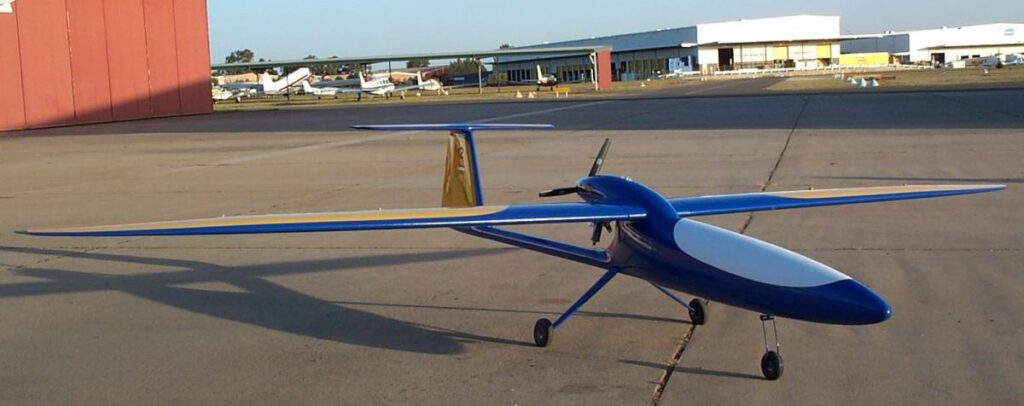
Flamingo® F-12 at Bankstown Airport, Sydney.

Bob Young kitted out with comms gear standing by a Mark 2 Flamingo® in the old Silvertone® Wagga workshop. Ken has since moved Silvertone® to new more modern and larger premises but still in Wagga.
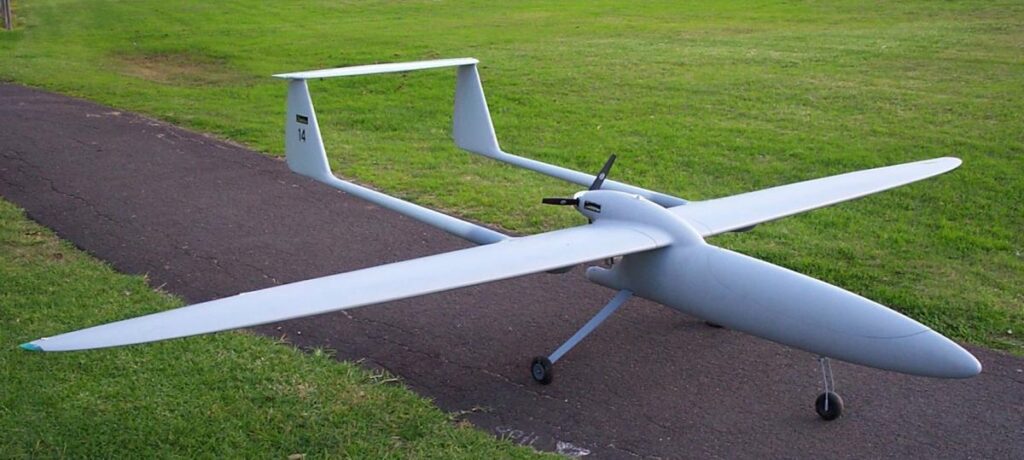
Twin Boom Flamingo® F-14
In 2011 the Civil Aviation Safety Authority (CASA) ran a test course for UAV pilots in Brisbane. The pupils covered a range of budding UAV pilots from those with extensive experience with remote control aircraft to those with absolutely no experience.
This course was run over two 5 day weeks and the results were very interesting. All of the pupils passed at the end of the course, each gaining a CASA Level 1 UAV controller’s licence. Bob Young was one of the instructors primarily teaching the students on the flight simulators. Bob Young was also invited to sit for the final exam and gained his Level 1 fixed wing UAV controller’s licence as well.

Class of 2011. CASA trial UAV training course participants including both students and instructors.

Playtime over it was time to knuckle down to some real work.
The flight simulators proved to be a very effective teaching tool and all of the students handled the actual models used in the flight training very well indeed.
In 2013 Bob Young sold Silvertone® Electronics to Mr Ken Taylor and the business was then moved to Wagga Wagga, NSW Australia; thus ended Bob’s Silvertone® caper almost 50 years to the day. June 1963 – September 2013, an incredible and highly satisfying career, absolutely crammed with memorable events.

What might have been had Bob stayed on. A concept drawing commissioned by Bob Young and done by Walter Radovitch of a jet powered high altitude Flamingo®.
And just what does that future hold for Silvertone®? Only time will tell but if it turns out to be anything like the past it should be very interesting indeed! If the Mark 3 Flamingo® produced by the new Silvertone® team is anything to go by it should be upwards and onwards.
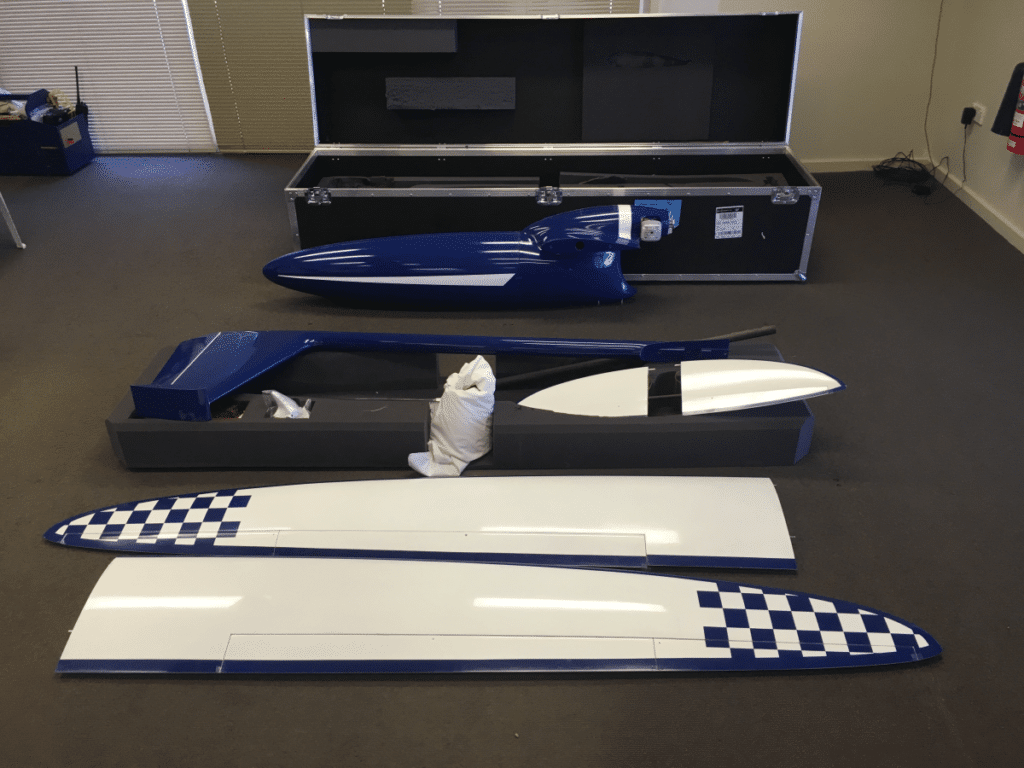
Silvertone® Mark 3 Flamingo® designed and manufactured by Silvertone® Electronics, Wagga Wagga, NSW.
Stay up to date with the latest news from Silvertone Electronics
Silvertone UAV is an Australian based, locally owned business invested in the design, development and manufacture and sales of Unmanned or Remotely Piloted Fixed Wing Aircraft, conducting business in the commercial sector, globally.
